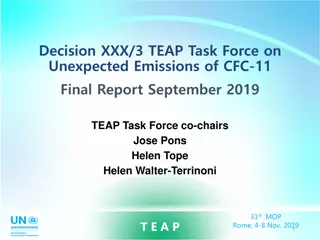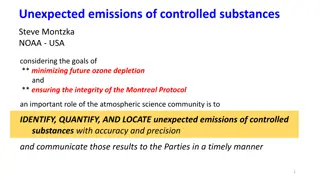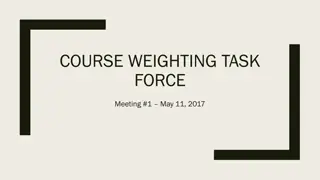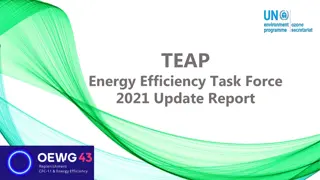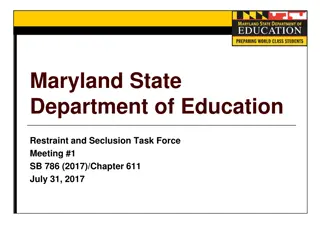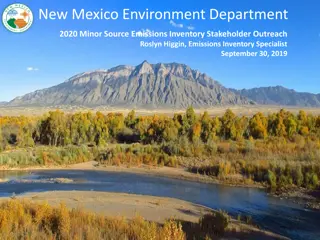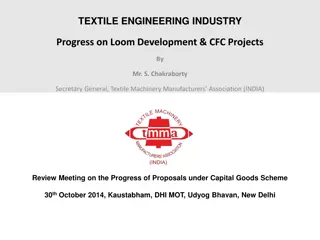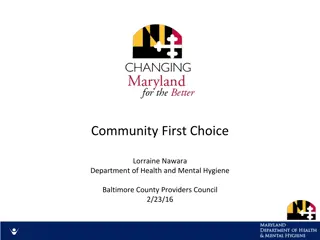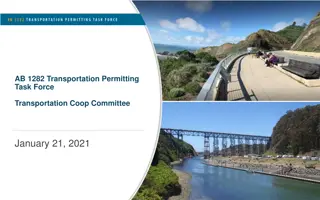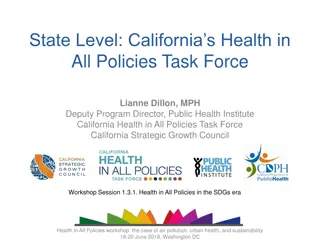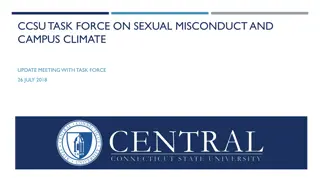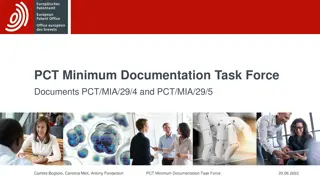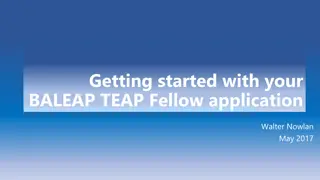TEAP Task Force Report on Unexpected CFC-11 Emissions
The Decision XXXI/3 Task Force report focuses on unexplained emissions of trichlorofluoromethane (CFC-11) and requests analysis of CFC-11 banks, linkages with production of other chemicals, product types, illegal production drivers, and more. Initiated by recent scientific data, the report aims to address the surge in CFC-11 emissions post-2012, with a focus on new findings and compelling insights to be presented at the Thirty-Second Meeting of the Parties.
Download Presentation

Please find below an Image/Link to download the presentation.
The content on the website is provided AS IS for your information and personal use only. It may not be sold, licensed, or shared on other websites without obtaining consent from the author. Download presentation by click this link. If you encounter any issues during the download, it is possible that the publisher has removed the file from their server.
E N D
Presentation Transcript
DECISION XXXI/3 TASK FORCE REPORT ON UNEXPECTED CFC-11 EMISSIONS TEAP TASK FORCE CO-CHAIRS JOSE PONS HELEN TOPE HELEN WALTER-TERRINONI 14 & 15 JULY 2021 1
Decision XXXI/3, paragraph 7 Decision XXXI/3: Unexplained emissions of trichlorofluoromethane (CFC-11) 7. To request the Technology and Economic Assessment Panel to provide the parties with an update to the information provided pursuant to paragraph 2 of decision XXX/3, and to provide a report thereon to the Thirty-Second Meeting of the Parties, including any new compelling information that becomes available, as well as providing information on the following: (a) An analysis of CFC-11 banks by geographic location and by market sector; (b) Linkages between the level of production of anhydrous hydrogen fluoride and carbon tetrachloride and unexpected emissions of CFC-11; (c) The types of CFC-11 products, the disposition of any such products, and opportunities and methods to detect such products and potentially recover the associated CFC-11; (d) Identification of possible drivers of illegal production of and trade in CFC-11, such as the availability of technically and economically feasible alternatives to CFC-11 and HCFC-141b and their sustained effectiveness. 2
Background to Decision XXXI/3 Initiated by scientific findings of unexpected increase in global CFC-11 emissions after 2012. Follows TEAP s response to decision XXX/3 in 2019. Decision XXXI/3 requests TEAP to provide an updated report to include available new compelling information and specific information as instructed. Coincides with decision XXX/3 SAP Report. To take account of emerging scientific information, parties agreed to extend: The timeline for both the SAP and TEAP reports until OEWG-43 The term of the TEAP Task Force to MOP-33 A TEAP Task Force was formed with new membership in 2020. 3
Decision XXXI/3 TEAP Task Force Members Jose Pons (co-chair) Helen Tope (co-chair) Helen Walter-Terrinoni (co-chair) Paulo Alto Paul Ashford Nick Campbell Marco Gonzalez Jianxin Hu Rabinder Kaul Lambert Kuijpers Relevant Expertise to the Task Force Production, aerosols, solvents Production, aerosols, solvents Foams, banks, emissions modelling Foams Foams, banks, emissions modelling Production, supply chain Montreal Protocol and institutions Production, phase-out Production, supply chain Refrigeration and air conditioning, banks, emissions modelling Production, supply chain Montreal Protocol and institutions Disposal, detection Refrigeration and air conditioning Foams Foams Production, supply chain Production, supply chain Catalyst, emissions modelling Production, supply chain, solvents Relevant Expertise to the Task Force Atmospheric science Modelling Affiliation MCTOC member MCTOC co-chair FTOC co-chair FTOC co-chair FTOC member MCTOC member TEAP Senior Expert MCTOC member MCTOC member RTOC member Party Venezuela Australia USA Brazil UK France Costa Rica PRC India Netherlands Andy Lindley Bella Maranion Elvira Nigido Fabio Polonara Miguel Quintero Enshan Sheng David Sherry Peter Sleigh Christina Theodoridi Jianjun Zhang Consulting Experts Paul Fraser Nick Harbeck MCTOC member TEAP co-chair HTOC member RTOC co-chair FTOC member FTOC member MCTOC member MCTOC member NRDC MCTOC co-chair Affiliation CSIRO Air-Conditioning, Heating, and Refrigeration Institute NOAA University of Bristol MIT Utrecht University UK USA Australia Italy Colombia Singapore UK UK Greece PRC Party Australia USA Steve Montzka Matt Rigby Susan Solomon Guus Velders Atmospheric science Atmospheric science Atmospheric science Atmospheric science and modelling USA UK USA Netherlands 4
Conclusions from the 2019 Decision XXX/3 TEAP Task Force Report A resumption of newly produced CFC-11 usage in closed-cell foams is the most likely explanation of the unexpected increase in CFC-11 emissions. Pre-2010 CFC-11 production and related usage, including historic foam banks, is unlikely to explain the increased CFC-11 emissions (2013-2018). Expected emissions from the pre-2010 CFC-11 foam banks in Northeast Asia are insufficient to account for the reported atmospheric-derived emissions from eastern mainland China. Newly produced CFC-11 usage is unlikely in refrigerant uses, flexible foams, aerosols, solvents, feedstock uses, tobacco expansion and other miscellaneous applications. The most likely CFC-11 production routes are: CTC to CFC-11/12 on a large-scale ( 50,000 tonnes/year) in an existing liquid phase plant (HCFC-22 and/or HFC-32 plant). CTC to CFC-11 on micro-scale (100 to 2,000 tonnes/year) plants using minimal equipment (to make low grade CFC-11 for foam blowing use). 5
Overview of the 2021 Decision XXXI/3 TEAP Task Force Report Sources of production and usage data Updates and refinements to the modelling Comparison of inventory-based expected emissions with emissions derived from atmospheric observations; estimated additional CFC-11 production and use based on our analysis Other topics that address decision XXXI/3: Analysis of pre-2010 CFC-11 banks by region and market sector Possible drivers of illegal CFC-11 production and trade Linkages between HF and CTC production and unexpected CFC-11 emissions CTC production to supply unreported CFC-11 production Possible fate of any co-produced CFC-12 Disposition of CFC-11 products (where are they and what happens to them?) Potential opportunities and challenges to recover and/or destroy CFC-11 and/or products Opportunities to detect CFC-11 in the field 6
CFC-11 production and usage data is critical in responding to questions Data for CFC-11 production and usage by market sector was available through the AFEAS network for the 1930s to 2003. Sales of CFC-11 were voluntarily reported by industry to the Alternative Fluorocarbons Environmental Acceptability Study (AFEAS). While extensive, the database did not include data from some countries (China, Czech Republic, India, North Korea, South Korea, Romania and Russia). Market sector data allows the allocation of production quantities to usage, and hence banks and emissions. Very helpful in limiting the uncertainties related to banks and emissions. Article 7 production data reported by parties was available through the Ozone Secretariat from 1989 onwards. Market sector data is not reported under Article 7. There is a serious need for more detailed current and future global data (production for each market sector, like AFEAS data or better) Critical to the Montreal Protocol s ability to better understand expectations of emissions and to answer future questions about emissions discrepancies, as a global check on compliance. 7
Refinements have improved the global and regional inventory-based modelling of CFC-11 production/usage The inventory-based model is a detailed inventory and representation of historic reported global CFC-11 production and use. The model estimates CFC-11 emissions and banks over time and throughout the life cycle of CFC-11 production, usage, in products, at end-of-life, based on available information, including emission rates, product lifetimes, sectoral and regional practices. Active bank refers to CFC-11 that remains in products still in use. Inactive bank refers to CFC-11 remaining in products that have been landfilled. Refinements to the modelling include: Using a Weibull distribution to better represent a range of lifetimes for chillers and foams in the active bank. Incorporating new information about refrigerant management practices. Using regional and product-based models to inform bank behaviours. Assumptions were tested and bounded, based on literature and expert input. 8
Comparison of inventory-based model of banks and expected emissions with derived emissions A compilation of CFC-11 emissions from different products at different life cycle stages from the inventory-based model produced the estimated expected total CFC-11 emissions profile on a yearly basis. The estimated expected emissions were compared with global emissions derived from CFC-11 atmospheric concentration measurements (called derived emissions) and an adopted atmospheric lifetime of CFC-11. As noted in 2019, an unresolved difference remains between observed CFC-11 emissions from foams in situ and emissions derived from regional atmospheric measurements. 9
Global inventory-based model of expected emissions compared with derived emissions from atmospheric measurements The inventory-based model s range of CFC-11 emissions uncertainties are represented by the blue band, and the blue line represents the mid-range scenario of estimated expected CFC-11 emissions based on reported production. The range of emissions and the mean emissions derived from atmospheric measurements are represented by the purple band and purple dashed line, respectively. 10
The difference between the inventory-based estimated expected CFC-11 emissions (blue) and derived emissions (purple) indicates unreported CFC-11 production and use Year 2007 Emissions from the pre-2010 CFC-11 bank alone cannot explain the derived CFC-11 emissions during 2013-2018. Unreported CFC-11 production and use would seem to have started before 2013, in the period 2007-2012. This is the first time that this observation is reported by TEAP and is based on the refined inventory-based model analysis. 11
Estimated additional unreported CFC-11 production and use, 2007-2019 Based on estimations of the additional CFC-11 production necessary for the inventory-based expected emissions to align with the derived emissions, unreported CFC-11 production is estimated to be: 10 to 40 kilotonnes per year between 2007-2012 40 to 70 kilotonnes per year between 2013-2018, the same as estimated in the 2019 Task Force Report for this period 15 to 40 kilotonnes of new production, or use from recent inventory, for 2019 Based on this analysis, the estimated cumulative total of unreported CFC-11 production is 320-700 kilotonnes during the period 2007-2019. Assuming usage in closed-cell foam production, this cumulative unreported CFC-11 production leads to an estimated increase in the magnitude of the CFC-11 bank of 300 (266-333) kilotonnes (~1.4 Gt CO2 eq) by end of 2019. 12
Analysis of pre-2010 CFC-11 banks by region and market sector Before 2010, the majority of reported global CFC-11 production and use in closed-cell foams was in non-Article 5 parties, specifically in North America and Europe. The quantities for Article 5 parties were much smaller. For pre-2010 CFC-11 foam banks: The majority was used in closed-cell insulating foams for construction and refrigeration, with most of the remaining global CFC-11 active bank in building insulation foams in North America and Europe. In 2021, there are an estimated 750 50 kilotonnes of CFC-11 in active foams banks, and an estimated 700 50 kilotonnes in inactive foam banks. Most of the active foam bank is in building stock in North America and Europe. For refrigeration foams, there are an estimated 100 kilotonnes of CFC-11 remaining in pre-2010 active foams bank in appliances; and an estimated 400 kilotonnes in the inactive foam bank. Most foams used in refrigeration appliances have already been decommissioned, either landfilled or destroyed. For centrifugal (CFC-11) chillers, the pre-2010 active bank of CFC-11 is estimated to be small compared to the active banks for closed-cell foams. 13
Cumulative regional CFC-11 produced and used in foam sub-sectors up to 2010 (kilotonnes) Closed-cell foam product type by region was estimated by adopting the 2006 FTOC Assessment Report breakdown of market share for each region to total use. The majority of CFC-11 containing closed-cell foams was produced in North America (NA) and Europe (EUR), mostly for construction and refrigeration. The majority produced in A5 parties was used in domestic refrigerators (orange). 14
What are the possible drivers of illegal CFC-11 production and trade? (1) There were likely a combination of drivers for illegal CFC-11 production and trade. For blowing agent use for closed-cell foams, possible drivers include: Higher pricing and lack of availability of HCFC-141b related to its phase-out. Economic attractiveness and technical feasibility of using CFC-11, if available. Technical ease of reverting to use of CFC-11, with compatible raw materials and equipment. The belief that flammability might be reduced by using CFC-11 as a blowing agent without the need for expensive fire retardants. Challenges with the HCFC-141b phase-out in the spray foam sector and for SMEs, including with the adoption of alternatives to HCFC-141b. 15
What are the possible drivers of illegal CFC-11 production and trade? (2) For the production sector, possible drivers relate to technical opportunity and economics: The most likely CFC-11 production routes remain large scale production on an existing liquid phase plant ( 50,000 tonnes/year), and production on micro- scale plants (100 to 2,000 tonnes/year). Purpose-built liquid phase swing plants: Can produce any one of CFC-11/12, HCFC-22, HFC-32 and can swing to produce one or the others. Have a larger range of allowable operating parameters to make a large range of products. Are designed to minimize economic impacts when swinging. Large plants built for production of a single product are technically capable of swinging to another product but at the cost of reduced capacity and product quality; economically less suited to swinging. Micro-scale plants would be low tech, low cost, easy to relocate, hard to detect, but limited economically by their small annual production capacity. More than 20 and up to 700 plants would be needed to match the large-scale unreported CFC-11 production. 16
What are the linkages between HF and CTC production and unexpected CFC-11 emissions? Given the most likely chemical production route, there are direct linkages between unreported CFC-11 production, associated unexpected CFC-11 emissions, and raw material production of anhydrous hydrogen fluoride (HF) and carbon tetrachloride (CTC). However, there are important differences between the HF and CTC production linkages with unreported CFC-11 production, associated with their different regulation, global demand and use. Strict regulation, relatively lower global production, and more limited patterns of use, make the CTC linkage the most important compared with HF in tracking potential CFC-11 production. HF is not heavily regulated; lacks international reporting requirements HF demand for unreported CFC-11 production would be only a very small fraction of global HF production HF is raw material for nearly all synthetic chemicals containing fluorine and aluminium trifluoride. 17
How much CTC was needed to supply estimated unreported CFC-11 production? 45 to 120 kilotonnes CTC would be required to supply 40 to 70 kilotonnes CFC-11 production annually in the period 2013 to 2018, depending on the proportion of co-produced CFC-12 (0-30%). The CTC quantity required for CFC-11 production is expected to be at the lower end of the range if, as predicted, the objective is higher CFC-11 selectivity. In the period 2007-2019, the cumulative CTC quantity required to produce 320-700 kilotonnes of CFC-11 would be at least 360 kilotonnes and could be considerably higher depending on CFC-11 selectivity. Given the scale and logistics of production, and that CTC supply for unreported CFC production went undetected, it seems more likely that CFC- 11 production occurred within the same country, and even on the same site, as CTC production. 18
Possible fate of any co-produced CFC-12 The quantity of CFC-12 co-produced with CFC-11 is dependent on the production route chosen, and how the plant is set up and operated. With CFC-11 as the intended target chemical, the range of CFC-12 co- production is up to 30% of total CFC-11/12 production for the most likely production routes. While substantial uncertainties exist, changes in global and regional CFC- 12 emission trends might be associated with unreported CFC-11 production. (SAP, WMO 2021) Any additional unexpected emissions of CFC-12 are likely to be as a co- product associated with the production of CFC-11, rather than from any specific production initiated to supply CFC-12 in its own applications. Emissions trends are more consistent with emissions releases during production than non-emissive uses. Although uses could not be ruled out. 19
Disposition of CFC-11 products: Where are they now and what happens to CFC-11? Opportunities to recover CFC-11 from products are limited to active banks, mainly of insulation foams and to a lesser extent of centrifugal chillers. For foams, landfill is the most common disposal practice. Nearly all CFC-11 is emitted over time, although some anaerobic degradation might take place. Foams and their blowing agents are recovered and destroyed (incinerated) in a small number of countries. Global total quantity is relatively small. Economies of scale are important in maximising benefits and minimising costs of recovery/destruction of CFC-11 foams. Combining foam wastes containing ODS and HFCs would realise the largest economies of scale and accrue the greatest benefits in recovery/destruction. The few remaining CFC-11 centrifugal chillers, mostly in the US, are likely to continue to be in operation for the next 10-20 years, and leak very little. If recovered, CFC-11 is either destroyed or is reclaimed for re-sale and reuse. 20
Up to ~1,100 kilotonnes CFC-11 from active banks are available for recovery The total pre-2010 active and inactive CFC-11 banks (foams, refrigerants and storage) are estimated to be 1500 100 kilotonnes (7.1 Gt CO2eq) in 2021. Pre-2010 active CFC-11 bank 800 50 kilotonnes (3.8 Gt CO2eq) Pre-2010 inactive CFC-11 bank 700 50 kilotonnes (3.3 Gt CO2eq) 300 34 kilotonnes (1.4 Gt CO2eq) is estimated to have been added to the active bank from unreported CFC-11 production and use during 2007-2019. Up to ~1,100 kilotonnes (5.2 Gt CO2eq) from pre- and post-2010 active banks are available for recovery. The global peak of decommissioned CFC-11 from active banks, when dismantled at end-of-life, is estimated to have occurred around 2010, at about 45 kilotonnes/year, then decreases slowly over time. There are underlying variations to the timing of regional peaks in CFC-11 foam decommissioning, where some regions and foam types are likely yet to have reached their decommissioning peaks, e.g., Europe for foam panels in buildings. 21
CFC-11 decommissioned from pre-2010 active banks, 1931-2050 (kilotonnes) Excludes estimated bank resulting from unreported CFC-11 production and use, 2007-201922
CFC-11 decommissioned from active banks, including new production, 1931-2050 (kilotonnes) Includes estimated bank resulting from unreported CFC-11 production and use, 2007-2019 23
Challenges and opportunities to recover and destroy CFC-11 The SAP 2018 Assessment concluded that future emissions from ODS banks continue to be a slightly larger contributor than future ODS production to ozone layer depletion over the next 4 decades . The potential opportunity for CFC-11 recovery and destruction lies in higher management of active foam banks at end-of-life, with potential diversion of foam wastes away from landfill towards destruction, which mitigates emissions. Investment and operating costs in ODS waste recovery and destruction present a challenge compared with relatively cheaper forms of disposition (venting and landfill disposal). Destruction costs represent a minor proportion of total costs of recovery and destruction, with recovery costs being the major portion and dependent on sector waste type, infrastructure, logistics, and transport distances. Lower internalised waste disposal costs for cheaper forms of recovery/ disposal do not include the externalised costs to society of future health/environmental impacts of emissions from venting or landfill disposal. With long building lifetimes, the drivers for recovery and destruction of CFC-11 building insulation foams might change over time. The evolution of net zero carbon requirements and the circular economy might improve end-of-life choices. 24
Opportunities to detect CFC-11 in products For field detection, one of the most used analysers is a portable device that determines refrigerant composition and purity for multiple refrigerant types and can be configured for detection of CFC-11, e.g., in storage drums. Also suitable for the drum headspace of polyol/blowing agent mixtures. Laboratory methods are well suited to CFC-11 detection in products, e.g., foam product samples. There has been only limited enforcement detection of illegal trade in CFC-11. Since 2010, there have been repeated plausible and authoritative indications of CFC-11 marketing for use in foams circulating within industry. Parties may wish to consider reviewing their enforcement programs and associated training to ensure opportunities to detect CFC-11 (or any controlled substance) are not being overlooked, and technical awareness about sampling and detection methods. Parties may also wish to investigate incentives and tools to encourage increased industry reporting of potentially illegal activities to authorities. 25
Summary conclusions (1) Inventory-based estimated expected CFC-11 emissions compared with global derived emissions indicate unreported CFC-11 production and use. Emissions from the pre-2010 CFC-11 bank alone cannot explain the derived CFC-11 emissions during 2013-2018. Unreported CFC-11 production and use would seem to have started in 2007. The estimated cumulative total of unreported CFC-11 production is 320-700 kilotonnes for 2007-2019. Assuming closed-cell foam usage, CFC-11 production leads to an estimated increase in the CFC-11 bank of 300 34 kilotonnes (~1.4 Gt CO2 eq). There were likely a combination of technical and economic drivers for illegal CFC-11 production and use in closed cell foams. Any additional unexpected emissions of CFC-12 are likely to be as a co-product associated with the production of CFC-11, rather than from any specific production initiated to supply CFC-12 in its own applications. Strict regulation, relatively lower global production, and more limited patterns of use, make the CTC linkage the most important compared with HF. The cumulative CTC quantity required to produce 320-700 kilotonnes CFC-11 would be at least 360 kilotonnes and possibly considerably higher. 26
Summary conclusions (2) Most of the global CFC-11 production and use in closed-cell foams was in North America and Europe prior to 2010. Opportunities to recover CFC-11 from products are limited to active banks, mainly of insulation foams and to a lesser extent of centrifugal chillers. The potential opportunity for CFC-11 recovery and destruction lies in higher management of active foam banks at end-of-life, with potential diversion of foam wastes away from landfill towards destruction, mitigating emissions. Relative investment and operating costs in ODS waste recovery and destruction present a challenge compared with cheaper forms of disposition (venting and landfill disposal). Future economics and environmental imperatives might improve end-of-life choices. 27
Summary conclusions (3) While sampling and detection methods and technologies are available, parties may wish to consider strengthening enforcement and training to ensure opportunities are not being overlooked to detect CFC-11 (or any controlled substance) and to alert authorities to illegal marketing or use. Critical refinements establish an important basis for future inventory-based modelling estimates: Better representing of equipment/product lifetimes in the active bank. Incorporating new information about management practices. Using regional and product-based models to inform bank behaviours. Testing and bounding assumptions based on literature and expert input. There is a serious need for more detailed global data (production for each market sector) which is critical to the Montreal Protocol s ability to answer future questions about emissions discrepancies, as a global check on compliance. 28


